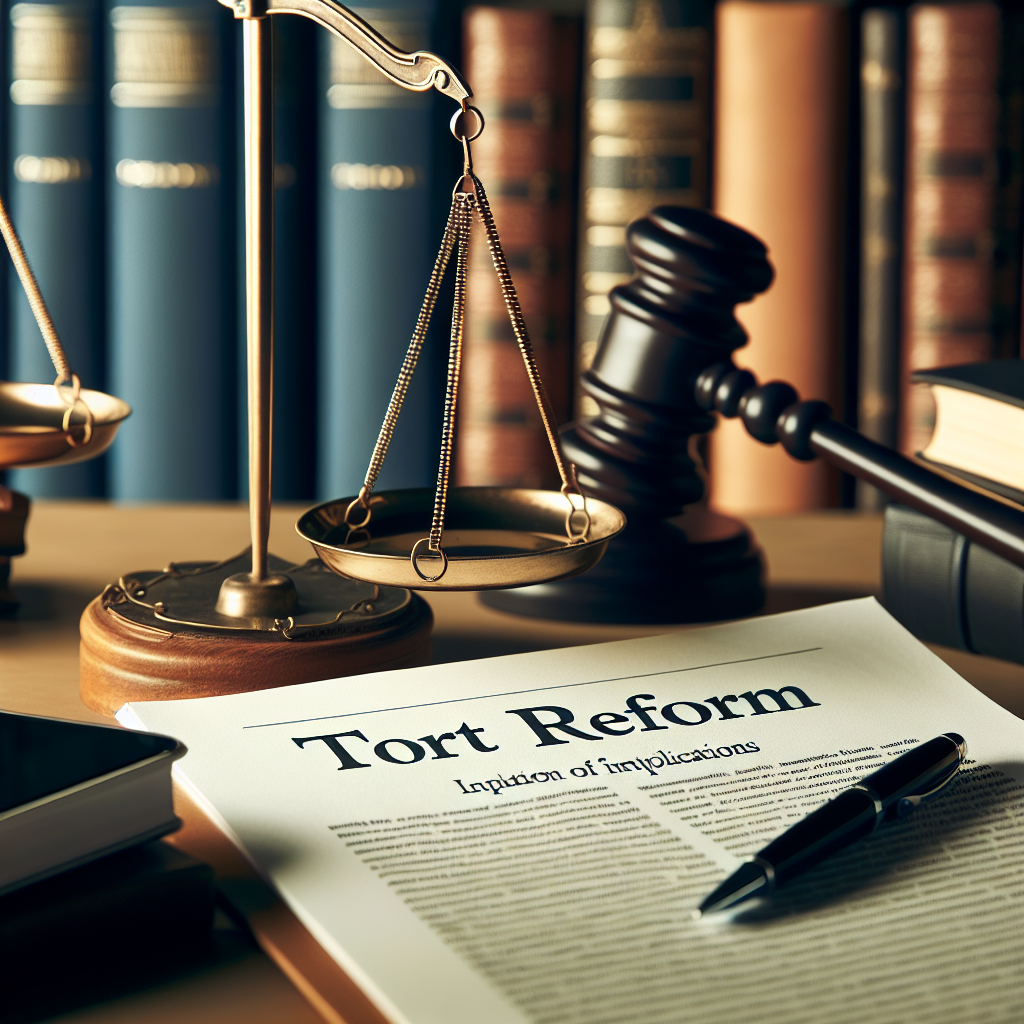The recent wave of tort reform laws has generated significant debate among legal experts, policymakers, and the public. These reforms, aimed at reducing litigation costs and limiting damages awarded in personal injury cases, have far-reaching implications for the legal landscape. As states continue to implement these changes, it is essential to explore their potential effects on the judicial system, claimants, and the overall pursuit of justice.
Overview of Tort Reform Legislation
Tort reform encompasses a variety of legislative measures designed to change how tort claims are handled in courts. These laws often include caps on damages, restrictions on the types of claims that can be filed, and modifications to the rules governing attorney fees. For instance, recent reforms in several states have introduced strict limits on non-economic damages, which can significantly impact victims seeking compensation for pain and suffering. Such limitations can create barriers for individuals pursuing legitimate claims, as seen in cases like the talc bankruptcy setback.
Additionally, some reforms aim to expedite the litigation process, promoting quicker resolutions to disputes. While this may benefit some parties by reducing legal costs, it can also undermine the thoroughness of the judicial review process. Critics argue that hastening legal proceedings can lead to inadequate consideration of evidence and a higher likelihood of wrongful judgments. Understanding the balance between efficiency and fairness is crucial as these reforms gain traction.
Impact on Claimants and the Legal System
The implications of tort reform extend beyond the courtroom, affecting the rights of claimants and the functioning of the legal system. One significant concern is that limiting damages may dissuade individuals from filing legitimate claims, fearing that the potential compensation will not justify the costs of litigation. This could disproportionately affect vulnerable populations who may already face challenges in accessing legal resources. As a result, the pursuit of justice could become increasingly inequitable, favoring those with greater financial means.
Moreover, the legal community is also adjusting to these changes, as attorneys must navigate new regulations and limitations. The reforms may lead to a shift in how lawyers approach cases, potentially prioritizing those with higher chances of success under the new rules. This shift could result in a decrease in the number of cases pursued, particularly in areas where damages are capped. Furthermore, ongoing debates about the constitutional implications of these reforms, especially regarding access to courts, are likely to influence future legal challenges.
As the landscape of tort law evolves, it is crucial for stakeholders to engage in discussions about the broader implications of these reforms. The intersection of public policy, legal rights, and societal values must be carefully considered to ensure that the justice system remains fair and accessible. For instance, the complexities surrounding privacy rights in the context of search and seizure also highlight the importance of maintaining a balance between individual rights and governmental interests, as discussed in the search and seizure cases.

The recent wave of tort reform laws has sparked considerable debate across various sectors, particularly in the legal and medical fields. These reforms, aimed at reducing litigation and associated costs, have far-reaching implications for claimants, defendants, and the judicial system as a whole. Understanding these implications is crucial for stakeholders who navigate the complexities of legal claims and liability.
Impact on Claimants’ Rights
One of the most significant implications of tort reform is its effect on the rights of claimants. Many reforms introduce caps on damages, particularly non-economic damages such as pain and suffering. This limitation can significantly diminish the compensation available to victims of negligence or malpractice, potentially jeopardizing their ability to recover fully from their injuries. For instance, in states that have enacted such caps, the talc litigation setback exemplifies how reform can limit the financial recourse available to individuals affected by corporate negligence.
Moreover, the increased burden of proof required under certain reforms can further complicate the process for claimants seeking justice. These changes often require victims to provide more substantial evidence of negligence, which can be particularly challenging in complex medical malpractice cases. Such barriers may discourage individuals from pursuing legitimate claims, ultimately leading to a chilling effect on the pursuit of justice.
Additionally, the introduction of stricter timelines for filing lawsuits can disadvantage claimants who may not be immediately aware of their injuries or the full extent of their damages. This aspect of tort reform can disproportionately affect vulnerable populations, such as those with delayed symptoms from medical conditions.

Effects on the Legal System
The legal system itself is also impacted by recent tort reform laws. With reduced litigation, courts may experience a decrease in case loads, potentially leading to faster resolution of remaining cases. However, this efficiency may come at the cost of thoroughness, as fewer cases could lead to less precedent-setting rulings. This scenario raises concerns about the development of case law and the implications for future litigants. Legal professionals are grappling with multidistrict litigation challenges that may arise as a result of these reforms, which can complicate legal strategies and client representation.
Furthermore, the financial implications for legal practitioners cannot be overlooked. As the landscape shifts, attorneys may find themselves navigating a new reality where fewer cases are pursued due to the barriers erected by tort reform. This shift could lead to a reevaluation of legal practices and business models, particularly for firms that specialize in personal injury claims.
In light of these challenges, some legal experts argue that tort reform may inadvertently lead to a decrease in accountability among corporations and healthcare providers. With reduced financial risks, there may be less incentive for these entities to adhere to safety standards and regulations, potentially resulting in an increase in negligent behavior. For example, the tort reform challenge showcases how legal changes can affect broader regulatory frameworks and corporate compliance initiatives.
The recent wave of tort reform laws has generated considerable debate regarding their potential impact on the legal landscape and society at large. These reforms are often introduced with the intention of reducing frivolous lawsuits and controlling rising litigation costs. However, the implications of these laws extend beyond mere cost savings; they can fundamentally alter the relationship between individuals, businesses, and the justice system.

Legal and Economic Ramifications
One of the primary implications of tort reform is the legal landscape’s transformation, particularly in terms of liability and compensation. As states implement caps on damages, the ability of injured parties to seek full restitution for their losses is significantly curtailed. This shift can lead to a chilling effect on the willingness of individuals to pursue legitimate claims, fearing that the potential compensation may not adequately reflect their suffering or losses.
Moreover, the economic ramifications of these reforms are multifaceted. While proponents argue that tort reform can reduce insurance premiums and encourage business investments, critics contend that it may lead to an erosion of accountability. Businesses might feel less incentivized to maintain high safety standards if they perceive a lower risk of litigation. Consequently, this could result in a long-term increase in workplace injuries and consumer risks, ultimately burdening the healthcare system and leading to higher costs for society.
Impact on Public Health and Safety
The implications of tort reform laws extend into the realm of public health and safety. When victims of negligence are unable to receive adequate compensation for their injuries, there may be a disincentive for individuals to report unsafe practices or conditions. This lack of accountability can lead to a culture where safety is compromised, as businesses may prioritize profit over the well-being of consumers and employees.
Additionally, the reduction in liability can also affect the quality of healthcare. For instance, if medical malpractice lawsuits are limited, healthcare providers may become less diligent in their practices, potentially compromising patient care. The correlation between accountability and quality of service is critical; when accountability is diminished, the incentive to adhere to best practices may decline.

Broader Social Consequences
Beyond the immediate legal and economic effects, the broader social consequences of tort reform laws warrant attention. The perception of justice within a society can be significantly impacted when individuals feel that their grievances cannot be adequately addressed. This sentiment can lead to a growing distrust in the legal system and a belief that the rights of individuals are secondary to corporate interests.
Moreover, as the gap between the powerful and the vulnerable widens, social inequities may become exacerbated. Communities that are already marginalized may find it increasingly difficult to seek justice, leading to a cycle of disenfranchisement and resentment. The implications of these reforms, therefore, extend well beyond the courtroom, influencing societal dynamics and the fabric of community trust.
In conclusion, while tort reform laws may be framed as necessary measures for economic efficiency, their implications are far-reaching and complex. The balance between protecting individual rights and fostering a conducive environment for business is delicate and requires careful consideration. Ongoing discussions surrounding these laws must take into account not only the immediate effects but also the long-term consequences for justice, safety, and societal equity. For a deeper understanding of the challenges posed by rising lawsuit costs, exploring the rising lawsuit costs can provide valuable insights.